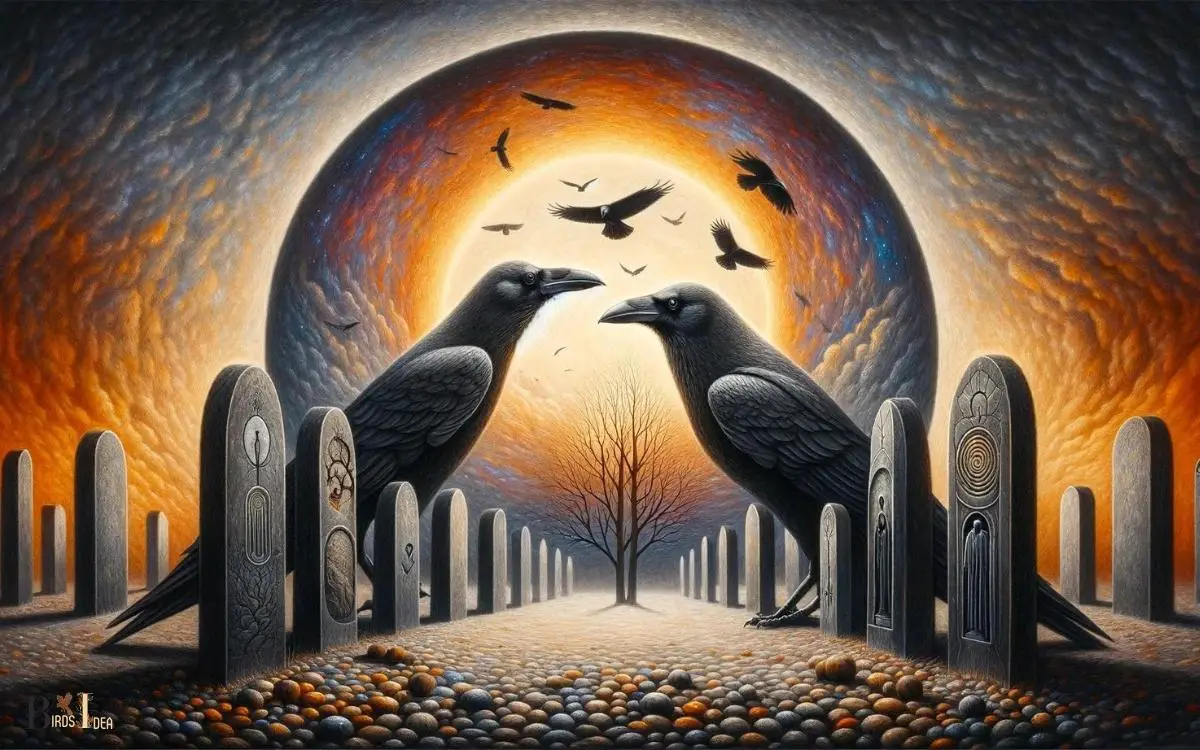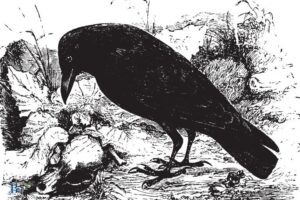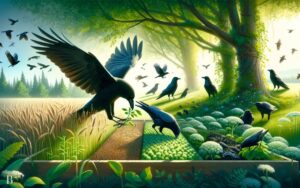What Crows Teach Us About Death? Read on to Learn!
Crows are known for their complex social behaviors, and recent studies have observed them partaking in what appears to be mourning rituals for their dead.
These rituals include gathering around the deceased, calling loudly, and sometimes bringing sticks or other objects, suggesting a level of understanding about death and the expression of loss.
Crows are highly intelligent birds, and their reactions to death are not merely instinctual but demonstrate cognitive processes.
Researchers have documented various behaviors that crows display when they encounter a deceased member of their species:
These behaviors indicate that crows may have a social response to death and could possess an understanding of the concept of mortality.
Their actions can be seen as a way to learn about potential dangers in their environment, as well as a method to strengthen social bonds within the crow community.
The observation of crow funerals not only opens a window into the emotional lives of these birds but also invites us to reevaluate our own perceptions of animal intelligence and empathy.

Key Takeaway
Crows’ Funerary Behavior
Crows’ funerary behavior demonstrates their capacity for complex social and cognitive processes.
These highly intelligent birds have been observed gathering around deceased members of their own species, displaying what appears to be a form of mourning.
They will often vocalize, gather in large numbers, and seem to inspect the deceased individual.
This behavior suggests a level of understanding and social organization that is not commonly associated with non-human animals.
The fact that crows exhibit such behavior sheds light on their advanced cognitive abilities and their capacity for emotional connections within their social groups.
This leads us to explore the concept of empathy and mourning in crows, delving deeper into the emotional lives of these fascinating creatures.
Empathy and Mourning in Crows
The observation of crows’ funerary behavior prompts an exploration of the potential for empathy and mourning in these highly intelligent birds, offering insight into the emotional depth of their social interactions.
Research suggests that crows may have the capacity for empathy, as they have been observed consoling distressed conspecifics and responding to the distress of others within their group.
This behavior indicates a level of emotional awareness and concern for the well-being of their fellow crows.
Furthermore, crows have been observed gathering around deceased members of their group, exhibiting behaviors that resemble mourning.
This raises intriguing questions about the emotional lives of crows and the potential similarities between their experiences of loss and those of humans.
Understanding the empathetic and mourning behaviors in crows provides a unique perspective on their social dynamics and emotional capacities.
This exploration of empathy and mourning in crows also sheds light on their perception of death.
Crows’ Perception of Death
Crows’ perception of death is a complex and fascinating subject that encompasses various aspects.
Their mourning behaviors, such as gathering around deceased crows and vocalizing distress calls, suggest a level of awareness and emotional response to mortality.
Furthermore, the existence of rituals and behaviors observed in crows after the death of a conspecific sheds light on their understanding and perception of the concept of death.
Crows’ Mourning Behaviors
Based on research findings and observational studies, crows demonstrate a clear understanding of death through their mourning behaviors.
When a crow encounters a deceased member of its species, it exhibits behaviors that indicate a level of comprehension and emotional response to the concept of death.
These mourning behaviors include gathering around the deceased, vocalizing in a distinct manner, and sometimes even performing a ritualistic dance.
This behavior suggests that crows have a perception of mortality and engage in mourning practices similar to humans.
The table below provides a summary of some mourning behaviors observed in crows:
| Mourning Behavior | Description | Significance |
|---|---|---|
| Gathering around | Crows gather around a deceased crow, sometimes in large numbers, as if paying their respects. | Indicates communal acknowledgment of death |
| Vocalizing | Crows produce unique calls and vocalizations when encountering a deceased crow. | Suggests an emotional response to death |
| Ritualistic actions | Crows have been observed engaging in ritualistic behaviors, such as hopping or gesturing towards the deceased. | Implies a symbolic understanding of death |
Crows’ Awareness of Mortality
Demonstrating a profound awareness of mortality, crows’ perception of death is evidenced through their intricate mourning behaviors and communal acknowledgment of mortality.
Crows have been observed exhibiting behaviors that suggest an understanding of death, such as gathering around deceased members of their species and vocalizing in a distinct manner.
These mourning rituals not only indicate an awareness of mortality but also highlight the emotional depth within crow communities.
Furthermore, studies have shown that crows are able to recognize individual members of their group, even after death, and may adjust their behaviors in response to the loss of a companion.
This awareness of mortality suggests a level of cognitive complexity and emotional depth that is often associated with highly intelligent and socially sophisticated species.
Understanding crows’ perception of death provides valuable insights into the cognitive and emotional capacities of these remarkable birds.
Crows’ Rituals for Deceased
The rituals crows perform for their deceased members provide compelling evidence of their profound awareness of mortality and their unique way of acknowledging death within their communities.
Crows have been observed gathering around deceased members, exhibiting behaviors that indicate a level of understanding and acknowledgment of death.
These rituals include vocalizations, gathering in large numbers, and even seemingly standing vigil over the deceased.
These rituals shed light on the depth of crows’ perception of death and the significance they attribute to the passing of their community members.
Understanding these rituals can provide valuable insights into the intricate nature of crow societies and their perception of mortality.
Transitioning into the subsequent section, it is essential to explore the role of crows in ecosystems.
The Role of Crows in Ecosystems
Crows play a crucial role in ecosystems, as they assist in maintaining ecological balance through their scavenging and predation activities.
Their presence has far-reaching impacts, influencing various aspects of the environment:
- Seed Dispersal: Crows aid in seed dispersal by consuming fruits and then dispersing the seeds across different locations. This process contributes to the regeneration of plant species and the maintenance of biodiversity.
- Ecosystem Health: By scavenging on carrion, crows help prevent the spread of diseases by reducing the buildup of decaying organic matter, ultimately contributing to the overall health of the ecosystem.
These activities underscore the significance of crows in sustaining the delicate balance of nature and highlight their irreplaceable role in maintaining healthy and thriving ecosystems.
Cultural Symbolism Surrounding Crows
Playing a significant role in ecosystems, crows have long been steeped in cultural symbolism, shaping various beliefs and narratives surrounding death and the afterlife.
Across different cultures, crows have been depicted as both bearers of bad omens and messengers of the spiritual world.
Here are some examples of the cultural symbolism surrounding crows:
| Symbolism | Culture | Meaning |
|---|---|---|
| Messenger | Native American | Communication between the living and dead |
| Guardian | Celtic | Protection of souls as they transition |
| Trickster | Japanese | Deception and transformation |
| Harbinger | Greek | Announcement of impending doom |
| Wisdom | Hindu | Divine knowledge and foresight |
The diverse interpretations of crows reflect the complexity of human perceptions of death and the afterlife.
This cultural symbolism surrounding crows has significant implications for human understanding of death.
Implications for Human Understanding of Death
Steeped in diverse cultural symbolism, crows’ representations as messengers, guardians, tricksters, harbingers, and bearers of wisdom reflect the multifaceted human perceptions of death and the afterlife.
This intricate relationship between crows and death holds significant implications for human understanding:
- Perception of Death: Crows challenge traditional views of death as finality, instead suggesting continuity and interconnectedness.
- Reflection: Humans may reconsider their understanding of mortality and explore the concept of an afterlife or spiritual existence.
- Role of Symbols: Crows serve as potent symbols, prompting contemplation on the nature of mortality and the soul.
- Integration: This challenges individuals to incorporate diverse perspectives into their personal beliefs about death and the beyond.
These insights from crows encourage a more open and expansive exploration of death, offering freedom in the interpretation of mortality and the afterlife.
Conclusion
The study of crows’ behavior surrounding death offers profound insights into the complexity of animal cognition and social dynamics.
Their funerary behavior and empathetic responses challenge our understanding of non-human intelligence and emotional capacity.
Furthermore, their role in ecosystems and cultural symbolism highlights the interconnectedness of life and death.
This research has the potential to revolutionize our understanding of death and the broader implications for our relationship with the natural world.






